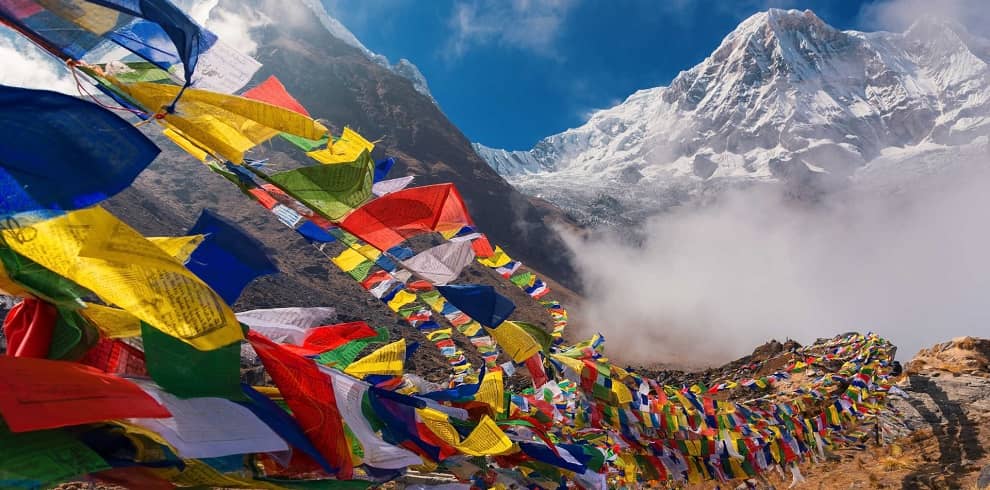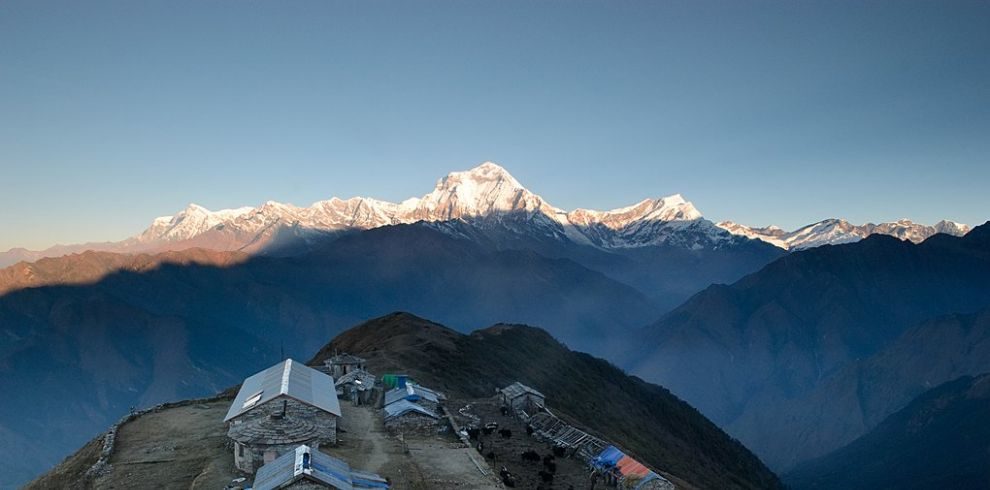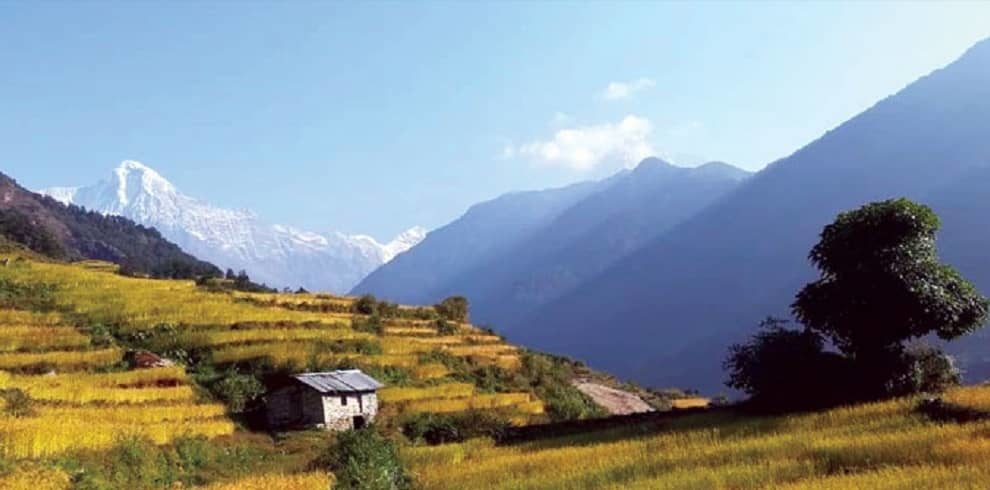Introduction To Annapurna Sanctuary Trek In Nepal
The Annapurna Sanctuary Trek begins with a climb from Modi Gorge into the Annapurna Sanctuary, passing through magnificent snow-capped mountain panoramas, awe-inspiring glaciers, and spectacular Himalayan scenery.
You’ll wander along the banks of pristine Himalayan rivers, soak in natural hot springs, and come across mule trains delivering supplies to isolated settlements.
As the journey progresses, you will have the opportunity to relax in warm mountain teahouses and connect with friendly locals, giving you an insight into Nepal’s varied culture and customs.
This sanctuary journey to Mount Annapurna (8,097m/26,566ft) Base Camp is a great way to ease into more difficult Himalayan hikes.
The paths are moderately strenuous and excellent for novices as well as experienced hikers, as they provide close-up mountain views with little risk of altitude sickness.
After a picturesque journey from Kathmandu, this nine-day trip begins at Dhampus. Dhampus is a culturally rich Gurung community with spectacular views of the Annapurna mountains, including Fishtail, Dhaulagiri, and Hiunchuli.
Our next trekking target is Landruk, from which we will have spectacular sunset views of Machhapuchhare (Fishtail), Annapurna South, and Hiunchuli. We will trek from Landruk to Chomrong and then to the Himalayas.
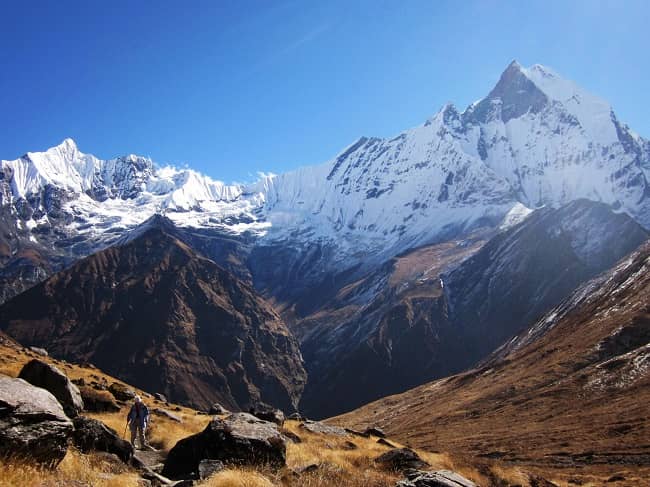
Annapurna Base Camp (ABC) is merely a one-day hike from the Himalayas, and Macchapuchhare Base Camp is located on the trail (MBC). The views of Annapurna South, Annapurna I, Annapurna III, Mt. Hiunchuli, Gandharvachuli, and Gangapurna are spectacular from MBC.
Similarly, Hiunchuli (6,441m), Annapurna South (7,647m), Fang (7,647m), Annapurna I (8,091m), Fluted peak (6,499m), Tent peak (5,663m), Glacial Dome (7,202m), Gangapurna (7,455m), Annapurna III(7,555m), Gandharva Chuli (6,248m), Gandharva Chuli (6,993m). The most excellent aspect of this hike is that you’ll get to stay in a hotel at Annapurna Base Camp for the night.
It’s time to head home after a night at ABC. The hike to Bamboo the next day will take you through Himalaya and Dovan communities.
You will arrive at Jhino Danda on the seventh day of your walk. Jhino Danda offers you the chance to soak your tired muscles in natural hot springs beside the river.
You’ll be staying at Jhino Danda for the night. You will trek to Ghandruk Phedi the following day and then take local transportation to Pokhara. You’ll return to Kathmandu the next day after spending the night in Pokhara.
The Annapurna Sanctuary Trek begins with a 6-7 hour bus travel (about 200 km) from Kathmandu to Pokhara, which is included in the package. However, we can arrange a local flight from Kathmandu to Pokhara (20 minutes approx) and vice versa for an additional fee. To attend the trip briefing, Discovery World Trekking recommends that our valued clients be in Kathmandu before 3 p.m., one day prior to the trek departure date. We will review your gear and equipment at the trip briefing and present you with vital information about the walk.
Highlights Of Annapurna Sanctuary Trek In Nepal
- Annapurna Base Camp is located at the foot of Annapurna I. (4130m)
- Jhinu Danda Hiunchuli, Annapurna South, Annapurna I, Khangsar Kang, Gangapurna, Annapurna III, and
- Machhapuchhare summits have hot springs where you may relax.
- Get a flavor of Nepalese living in the countryside.
- Base Camp Machhapuchhare (4000m)
Benefits Of Annapurna Sanctuary Trek In Nepal
- Transfer from the airport to the hotel is included in a private vehicle.
- Pulse oximeters are used to monitor blood oxygen saturation levels in order to detect early indicators of imminent altitude sickness and other health hazards.
- First-aid kit
- Excess luggage can be stored for free during the trek at our facility.
- If you don’t have your own, make arrangements for sleeping bags and down jackets.
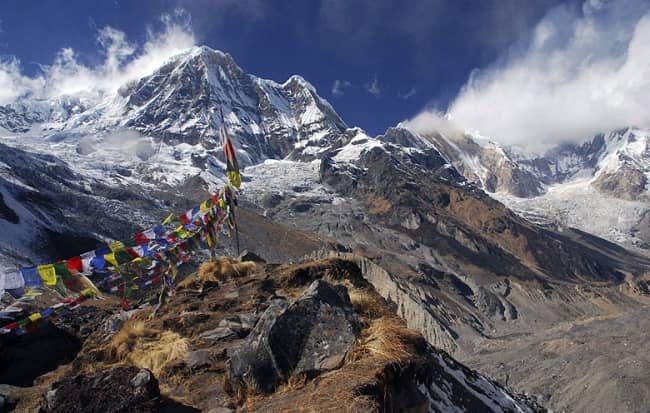
Equipment list for Sanctuary Trek
While packing for this expedition, we recommend that you consider the following list of clothing and accessories. We understand that you may have your own particular taste in apparel, which is quite acceptable. Please just bring what you absolutely need. Your luggage will be carried by porters, however, the weight limit is 9 kilos.
Head
- Scarf or hat for the sun
- Winter hat, insulating hat, or a hat with a wide brim
- Extra batteries for the headlight
Face
- Sunscreen
- Sunglasses that block UV rays
- Wipes for the face and body
Hands
-
Lightweight gloves
-
Heavyweight winter gloves
Body
- Shirts for hiking
- Shirt with a long sleeve made of synthetic fiber.
- Rain jacket with hood
- Jacket made of fleece
- Cotton pants that are light and airy.
- T-shirt (bring lightweight wool)
- Underwear made of polypropylene
- Jacket with down feathers (available for rent in Kathmandu)
- Sweater
- Jacket and pants that are waterproof
Footwear
- Boots for Hiking
- Socks made of thick wool (Take an extra pair of thick light socks)
Essential gear
- A daypack or a backpack (Size depends on whether you take a porter or not)
- Bottle with a heating element
- Purification of water
- Pole for hiking
- Bag for sleeping (-15 degree bag is best for high altitude trekking)
Toiletries
- a drying towel of medium size
- Toothbrush
- Toothpaste
- Deodorant/floss/toilet paper
- Biodegradable soap in a bar
- a pair of nail clippers
- Mirror, little
Personal accessories
-
Money
-
Watch
-
Cell phone
-
Camera
Extra items
- Kit for first aid
- Extra passport pictures and passport photocopies
- Pencil and notebook
- Binoculars
Trek Difficulty, Cost, Best Time & Tour info
Guided Sanctuary Trek
The majestic Mt Annapurna massif is located in central Nepal, around 50 kilometers from Pokhara. The Annapurna Sanctuary is one of Nepal’s most famous tourist destinations. His walk is moderate and reasonably easy, taking him all the way to Annapurna Base Camp.
You can drive or fly to Pokhara from Kathmandu and then take local transportation to Ghorepani. Aside from geographic safety, we take the following steps to ensure your safety during your journey.
- Our guides have received extensive wilderness first-aid training.
- For motivation and encouragement, we brighten your attitude.
- We review meals and accommodations for hygiene.
- Our trip leaders and guides have years of trekking experience.
- Throughout the journey, we’ll have high-quality masks and gloves with sanitizers for our crew to aid you.
Sanctuary Trek Start
We will greet you with a Marigold garland as soon as you arrive at Tribhuwan International Airport and transport you to your accommodation in a private vehicle. You will, however, need to come to our office for a trip briefing. We may hold a tour briefing in your hotel if you are a group.
On the day of your departure, we’ll take a tourist bus to Pokhara. The journey to Pokhara will take 6 to 7 hours and will begin at about 7 a.m. We’ll take a jeep or taxi from Pokhara to Dhampus, our destination for the day.
This hike package includes a tourist bus ride from Kathmandu to Pokhara in both directions. For an additional fee, you can fly or utilize private transportation (Kathmandu – Pokhara – Kathmandu).
We offer a free airport transfer service
Sanctuary Trek Accommodation Information
The Sanctuary trip package includes eight nights of lodge-to-lodge lodging at the trek regions’ best lodges/tea houses, as well as one night in a Pokhara hotel.
At Dhampus, Landruk, Chhomrong, and Jhino Danda, we offer four nights of twin sharing accommodations with private attached bathrooms, and three nights of twin sharing standard rooms at Himalaya, Annapurna Base Camp, and Bamboo. In Pokhara, you will spend the night in a hotel. The accommodation has a private bathroom, TV, 24-hour hot water, electricity, and a laundry facility.
Wherever possible, we will provide a single private room with an attached bathroom for solitary hikers, as well as a single private room in other locations.
Two nights at a hotel in Kathmandu are required before and after the hike, however, they are not included in the package. There are hotels in Kathmandu to suit all budgets and interests.
At hike locations, hot showers and Wi-Fi will be offered for an additional fee.
Food
The Sanctuary journey will take you to high altitudes near some of the world’s tallest peaks. As a result, you’ll require a nutrient-dense diet. We will provide you with enough nutritious and appetizing meals, but your options will be limited in comparison to those in cities.
During the walk, there will be nine breakfasts, eight lunches, and eight evenings.
The following are some of the most popular menu items:
Oatmeal, Corn Flakes, French Toast with Jam, Butter, Cheese, Honey Tibetan bread, or Chapati are among the nine-morning options. Tsampa porridge is a traditional local dish. Fruits and vegetables, as well as eggs, pancakes, and muesli bread Drinks that are heated (varieties of teas and coffees, hot chocolates, etc.)
Eight lunches: Dhal, Bhat, and Tarkari, Tibetan Bread, Soups, Sherpa Stew, Steaks, Sandwiches, Momo (dumplings), Macaroni dishes, Tenduk Spaghetti Noodles, Thukpa, Pasta, Vegetable curry, Potatoes, Vegetables, Salad Pizza (Tomato, Mushroom, Mixed), Snacks (Papad, Prawn), Desserts (R
Dhal, Bhat, and Tarkari, Tibetan Bread, Various Soups, Sherpa Stew, Steaks, Sandwiches, Momo (dumplings), Macaroni, Tenduk Spaghetti, Noodles Thukpa, Pasta, Vegetable curry, Potatoes items, Vegetable and salad Pizza (Tomato, Mushroom, Mixed), Snacks (Papad, Prawn), Korean Raman, Desserts (Rice
We choose the best lodges, restaurants, and tea houses that serve fresh, clean, delicious, and nutritional meals. Traditional, Asian, and western cuisine are all available on the menu. However, as you ascend, the menu list becomes more limited.
At high elevations, we strongly advise you to consume fresh vegetables and liquids such as green tea, lemon tea, hot lemon, ginger tea, and garlic soup (a necessity).
There are many non-vegetarian options accessible in hike locations, but we don’t advocate them because the meat may not be hygienic. At high elevations, we strongly advise you to avoid dairy and to avoid alcoholic beverages, caffeinated beverages, and hot chocolates.
Note: Lunch and dinner in Pokhara are not included in this package.
All personal bills (alcoholic, hot (tea/coffee), and cold drinks) in tea houses, lodges, or cafés are excluded from the package, save for standard meals (breakfast, lunch, and dinner with seasonal fruits).
Sanctuary Trek | Best Time | Climate Information
The weather is the most important consideration when planning an Annapurna Sanctuary Trek. Throughout the year, people travel to Annapurna Base Camp. There are seasons, though, when the treks are easier and the sights are more beautiful.
Trekking is best done in the spring and autumn seasons. From twilight till morning, the skies are perfectly clear throughout this time. The most beautiful landscapes are created by the magic of bright azure skies. Trekking in the winter can be difficult owing to heavy snowfall and severe temperatures, but it can also be exciting for some hikers.
Although trekking may be done at any time of year, each season has its own set of benefits and attractions. In a nutshell, this section contains thorough information regarding the meteorological conditions at high altitudes.
March to May (Spring)
The Annapurna Sanctuary hikes in the spring (March-May) draw a huge number of mountaineers and travelers. The weather is pleasant, the rainfall is light, and the trekking conditions are ideal during this time. At the Annapurna Base Camp, the average daily temperature ranges from 8°C to 0°C. The trek’s lower portions are warmer, making it more pleasurable.
In March, the hiking season begins. Even at elevations of nearly 3,000 meters, the Himalayan trek path will be full of rhododendron blossoms by April. From mid-March until mid-May, the temperature begins to rise.
June to August (Summer)
Summer in Nepal occurs in the months of June, July, and August. In comparison to other months, summer has the most favorable hiking conditions. However, when the monsoon coincides with summer, you must exercise greater caution because the trekking trails may be wet and slick.
The monsoon season begins at the end of June and lasts until the second week of August. Daytime temperatures typically vary from 10 to 23°C, while nighttime temperatures hover around 5 to 10°C. The sky is normally clear in the morning, but clouds build up in the afternoon and disappear at night. Though the rain may pose some issues, a variety of flora blossom during this time, giving green cover to the lowlands.
September to November (Autumn)
Autumn, like Spring, is a fantastic trekking season that attracts visitors from all over the world to hike to Annapurna Base Camp. Autumn is a great trekking season because of the moderate temperatures, light winds, and low precipitation.
The sun is shining brightly, the skies are clear, and the views of the mountains are spectacular. You will also be able to see the stars well at night. By early September, the monsoons will have passed, and you will be able to enjoy mild to warm days.
In high altitudes, daytime temperatures can exceed 20°C. The nights are chilly, with temperatures hovering around 5°C. The monsoon greens fade to a golden/amber color, creating a stunning contrast against the pristine blue skies. In the enclaves, you’ll also find cereals ripening.
The lowlands are lush and the environment is clean. Furthermore, the two most important Nepali holidays, Dashain and Tihar, fall at this time.
December to February (Winter)
Treks in the Annapurna region in the winter are less popular than treks in the spring or autumn. Although the journey sections can be frigid, some trekkers enjoy it. The temperature at Annapurna Base Camp might drop below -10 degrees Celsius.
The coldest month is December, which lasts until the beginning of February. The climate progressively warms from late February, with temperatures around -5 °C at high altitudes. The weather is lovely and warm during the day. Despite the cold, the winter skies are clear, and the mountains are breathtaking to see. Some sections of the track, however, will be covered with snow. Although it is not the best season for beginners, experienced hikers will have little difficulty.
The weather in the Himalayas is changeable and unpredictable.
Annapurna Sanctuary Trip Grade: Fitness level | Medical & Health Information
The Annapurna Sanctuary Journey is a moderately difficult expedition that culminates at Annapurna Base Camp (4130m), the highest point on the trek.
Hiking time per day varies from 4 to 7 hours, with several stops to take in the breathtaking scenery. Long ascents, severe descents, and straight paths are all part of the courses.
Because trekking at a higher altitude is physically hard, you will spend more time trekking in the lowlands and fewer hours in the high mountains. It would be advantageous if you have prior hiking experience, but you do not need any technical abilities or experience.
You must be reasonably fit and prepared for long trekking days because some days require extended awake hours. Your walk will be more fun if you are physically fit. It is a good idea to exercise and jog frequently for a couple of weeks prior to the trip to improve your stamina.
Our trekking leaders and guides are well-trained in first aid and have a lot of expertise. Oximeters are used to monitor your oxygen levels and to discover health issues like altitude sickness earlier. You may rest certain that your health is in capable care.
You will also be advised to take precautions by your hike leader or guide. All participants must be in good health and possess a positive attitude, self-confidence, and tenacity. Before scheduling the trek, trekkers with pre-existing medical issues such as heart, lung, or blood disease should let us know.
Group & Private Treks
We can arrange both a group and private trek. The group discount is applied when you have your own taxes in your group, and the pricing is the same whether you join a group or go on a solo tour. We have the ability to lead and manage groups of varying sizes. For groups of 12 or more trekking members, there will be a group leader, a porter for every two trekkers, and an assistant guide.
A typical day
Each day will provide you with a unique trekking experience, including scenic views, photo opportunities, and exploration of local settlements. Our Sherpas/guides will accompany you and will provide you with information about the areas you will visit. Our bags will be carried by porters.
You will, however, be carrying a tiny standard bag pack containing your valuables. The day begins with a cup of tea or coffee in the morning. Following a hearty breakfast, we start off on the day’s walk between 7 and 8 a.m., depending on the length and nature of the trek.
After trekking for three or four hours, we offer lunch around midday. After that, you’ll get an hour of rest. The afternoon stroll is usually shorter, lasting between two and three hours. You can nibble on the extra dietary food once you get at our overnight lodge/tea house/tent. Then you’re free to go exploring in the area.
Dinner is served between 6 and 7 p.m. You can engage in polite talks and discuss your day’s events after dinner and before going to bed. The trek leader/guide will give you an overview of the itinerary for the next day. Following this lecture, you can relax by reading novels, playing board games like monopoly, playing cards, or watching mountaineering documentaries. The majority of tourists learn Nepalese from our crew in a relaxed and enjoyable manner.
Communication during the trek
Internet access is available at the lodges where you will be staying for a modest fee. We will, however, use phones to converse at high altitudes. Every trek team will be contacted at least once a day by phone via trek lead. We do this to guarantee that everyone is safe and that the journey runs well. In Kathmandu, you can get a local sim card, although the signals may not be strong enough.
Wi-Fi is provided at teahouses/lodges for an additional fee.
Electricity and water
Electricity for camera and mobile battery recharge is offered at an additional fee throughout the Annapurna Sanctuary trip lodges.
You have the option of purchasing packed mineral water from local lodges and en route shops or filling your water bottle with boiled water purchased from lodges/tea houses. We can also supply you with water purifying pills if necessary.
Drinking water from rivers, taps, and wells in trek areas is not recommended because the water may not be as potable as it appears.
Extra personal expenses
Our clients are responsible for their own meals and lodging in Kathmandu. There are hotels/lodges to suit all tastes and budgets in Kathmandu.
All of our valued clients must bring spending money for meals and lodging in Kathmandu, as well as lunch and dinner in Pokhara. Similarly, you will require funds for visa processing, travel insurance policy purchase, hike snacks, hot (tea/coffee) and cold drinks, crew member tips, souvenirs, and other expenses. We recommend bringing cash (major currencies) to Kathmandu and exchanging it for Nepalese Rupees. Only Nepali Rupees are accepted in trek areas.
Sanctuary Trek Travel Insurance
The Sanctuary Trek is a moderately difficult hike with a low risk of high altitude sickness. It is not, however, as fully risk-free as a mountain trek.
Injuries, illnesses, floods, landslides, and abrupt climate changes are all possibilities. As a result, travel insurance is required. We require a copy of every trekker’s complete travel insurance policy certificate. Medical and emergency repatriation must be covered, as well as helicopter rescue and evacuation costs at the greatest trek elevations.
Based on our clients’ experiences, we may recommend insurance firms. We do not, however, sell insurance coverage.
Trekkers are asked to give their comprehensive insurance information within a week of booking their trek. We will use your insurance policy and other informative documents you supplied us to arrange a quick rescue in the event of an emergency.
Please call the insurance companies and ask if they provide heli-rescue at the highest hike altitude when acquiring insurance coverage (4,500m). Do not just rely on the material of the insurance company’s website.
Visa | Nepal Tourist Visa Info
To enter Nepal, all foreigners save Indian nationals must have a valid visa. Visas are available upon arrival at Tribhuvan International Airport in Kathmandu, Nepal, as well as at Nepal’s Indian and Tibetan borders. It is simple to extend a visa to the central immigration office. www.immigration.gov.np; A passport with at least 6 months remaining on its expiration date and one passport-size photo are required for visa applications.
The current cost of a 30-day visa is US$50 (must be paid in cash) for 30 days, which must be paid in cash. Other currencies are accepted as well, though exchange rates may vary. Other nationalities should double-check the conditions for admittance.
Visitors are asked to provide details about their return flight tickets and the length of time they want to spend in Nepal. We recommend adding at least 1-2 days to your journey at the conclusion just in case there is a delay. If there is no delay, we can plan an additional activity for you during your stay in Nepal.
A free visa will be given to youngsters under the age of ten. It is strongly recommended that you examine the current regulations. Visa regulations are subject to change at any time. A free visa is available to Chinese citizens as well as citizens of the South Asian Association for Regional Cooperation (SAARC) countries (Bangladesh, Bhutan, India, Maldives, Pakistan, and Sri Lanka). Nigeria, Ghana, Zimbabwe, Swaziland, Cameroon, Somalia, Liberia, Ethiopia, Iraq, Palestine, and Afghanistan are among the nations that are not eligible for a visa on arrival.
Please contact your nearest Nepalese embassy if you are a citizen of one of these countries.
Currency Exchange in Nepal | USD to NPR
Nepali Rupees (NPR/Rs) are the local currency.
(1 USD = Rs.100-118 NPR).
In Kathmandu and across Thamel, we may exchange most international currencies at local banks and reputable money exchanges. The hotel can also exchange small sums of cash.
The current currency rate is clearly indicated. The Nepalese government has outlawed the import, export, and usage of 500 and 1000 rupee notes. You should not carry these notes with you when you arrive in Nepal, as they will be confiscated and you may be punished.
Despite the security of traveler’s cheques, we choose cash conversion to avoid the difficulties of a long process and a hefty commission rate at the banks. You can get cash (only in Nepalese Rupees) at one of the many ATMs in Kathmandu and Thamel. There are a number of ATMs that are open 24 hours a day. If you use your foreign card, the maximum withdrawal amount is 35,000 Rupees with a 500 Rupee processing fee.
If you utilize a bank or financial institution’s money exchange service, you will be charged a service fee of around 4% or more, depending on the bank.
Because there are no banks or money exchange services along the trail, you should exchange your money in Kathmandu alone, depending on how much personal expenditure you anticipate, as individuals in the Himalayan region only accept Nepalese currency.
Foreign currency notes that are old, damaged, or faded will not be accepted by the majority of Asia’s established banks. Please make sure you have fresh, clean notes.
How much luggage can I bring to the Sanctuary Trek?
Porters will be allocated to carry your luggage; two passengers will be assigned to one porter, and combined luggage should not exceed 9 kg. Our porters are never overworked. However, you should bring your own rucksack or backpack (with any valuables or important items) with you. Only bring what you absolutely need; any excess baggage can be left at your hotel or at our store for free and will be kept safe.
Before we leave our office, we’ll double-check everything (luggage, equipment, etc.) in our briefing.
Annapurna Sanctuary Trek Safety
We ensure the safety, security, and contentment of our valued customers. For us, the most crucial concern is safety. We’ll be carrying all of the required gear, equipment, and first-aid kits for the hike. Our leaders and guides are well-versed on the subject and have received comprehensive first-aid training.
If a trekker becomes ill as a result of the altitude, the trekker must determine whether or not to continue, as health is paramount. In the event of an emergency, the rescue chopper will be on standby to transport you back to the lower elevation. During the journey, each group will stay together to ensure that no one gets separated.
Eco-tourism
We are convinced that our ecosystem must be safeguarded, as tourism may have severe consequences. We emphasize the benefits of tourism to the environment. Furthermore, we collaborate with the Kathmandu Environmental Education Project (KEEP) to offer environmentally conscious and culturally engaging itineraries that match the expectations of both passengers and communities.
Our Crew
Our local best-trained and well-experienced guides / Sherpas will accompany you on the trip to make your journey even more pleasant and unforgettable. All of our guides are well-trained and licensed, and they have spent years trekking and climbing peaks all over the world.
Your stuff will also be carried by porters. One porter will be assigned to two people. The total weight of your luggage should not exceed 9 kg. Our porters are never overworked. We assign one porter to each of the two members and one assistant guide to each of the eight members.
We can additionally have one porter per passenger if necessary. Our crew members are locals from high Himalayan remote locations, and due to their physical endurance and heredity, they can live peacefully and readily at high elevations. All of our employees are extremely valuable to us; they are highly compensated, and we provide insurance, clothing, food, and accommodation for them throughout the expedition.
When our guides and porters become unwell or injured, they receive medical attention. We make every effort to ensure their happiness since we believe that only happy people can make others happy. The local expert trek leader who will be guiding you is an expert in the following subject. We provide modest lodging for our guides and porters, such as a tent with sleeping gear, as well as meals and warm beverages.
- Authorized Trekking Guide Training Certificate
- Intensive Wilderness First Aid Training
- Fluency in English and another major language
- Conservation and Biodiversity Training
- Experience with rock climbing
Tipping
Tipping is accepted and respected in Nepali society, and it is a form of expressing thanks. Tipping is at the discretion of hikers and is based on service quality. We recommend tipping at the end of the hike and as a group.
100 % Secure Booking | MasterCard | Visa | American Express
We are a government-approved and bonded trek and tour company in Nepal. We are also members of the Nepal Mountaineering Association (NMA) and the Trekking Agency Association of Nepal (TAAN) (NMA). As a result, you may book your trek/expedition with complete trust.
As a deposit, we require 10% of the total trip cost. Within a week of booking, please send your documentation, including a copy of your passport, passport-size pictures, travel insurance policy, and arrival and departure flight information.
You can make a 10% deposit via bank transfer, western union, or online payment on our website, and the full balance when you arrive in Nepal. Cash, bank transfer, and credit cards are all acceptable methods of payment. In addition, you will receive payment choices in your email.
Last-minute booking
We offer last-minute bookings for individuals who are unable to book Annapurna Sanctuary Trek in advance. You must pay 100% of the trek cost 24 hours before the trip begins to take advantage of this service.
We make every effort to run last-minute treks/trips on your scheduled date. However, there is a slight potential for a journey delay owing to factors beyond our control, such as terrible weather or a lack of housing.
Trip Extensions
If you have extra days after the trip, you can embark on a sightseeing tour in Kathmandu or the surrounding districts. In Chitwan, you can also embark on a jungle safari, paragliding, rafting, canyoning, or other treks.
Feedback
We don’t demand anything in return except feedback (both positive and negative) on our services and team’s performance. We will make changes as a service provider based on your input on our overall performance. Your feedback assists us in carrying out future goals by identifying and addressing flaws as well as maintaining strengths. We invite you to express your true feelings and experiences on prominent social media sites such as Facebook and Trip Advisor.
You may also visit Joy of Rafting over the Trisuli River-Cost, Distance, Itinerary, In Nepal – 1 Day
Overview Of Annapurna Sanctuary Trek
- The Annapurna Sanctuary Trek begins on the bank of the beautiful Phewa Lake and continues upstream through the Modi Khola to the heart of the Annapurna Sanctuary and around the middle portion of the Annapurna peaks.
- The journey will take you through a wide variety of terrain, including terraced rice fields, glacial moraine, and sparkling lakes.
- We delve into the visual splendor of the monasteries, as well as the culture and tradition of the Gurung and Thakali people, to add to the natural beauty of the location. The exhilarating Thorong La Pass, the well-known Muktinath Temple, and the soothing hot spring are just a few of the numerous highlights of our walk.
